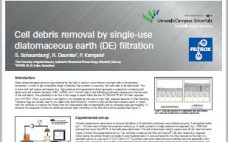The rapid spread of contagious and lethal diseases worldwide has driven bioprocess suppliers to develop technologies for use in producing disease treatments and vaccines. Bioprocessors need to develop new biologics as well as rapid and reliable methods for bringing those treatments to commercialization. Implementing modular process solutions and single‑use handling systems in closed‑manufacturing processing is one approach to addressing those needs. Developing and discovering solutions for meeting global healthcare conditions is an evolving part of bioindustry. As points of reference,…
Tuesday, November 17, 2015 Daily Archives
Special Report on Assays, Test Methods, and Comparability: The CMC Strategy Forum Series, Part 4, Introduction
The CMC Strategy Forums focus on relevant chemistry, manufacturing, and controls (CMC) issues throughout the life cycle of a therapeutic and thereby foster collaborative technical and regulatory interaction. Forum chairs share information with regulatory agencies to help them merge good scientific and regulatory practices. Outcomes of the forum meetings are published in BioProcess International and on the CASSS website (www.casss.org). This process is meant to help ensure that biopharmaceutical products manufactured with advancing technologies in a regulated environment will continue…
Rapid High Performance Quantification of Human IgG Using an Automated Gyrolab System
The development and manufacture of biotherapeutics requires efficient and timely analytical support to monitor both quantity and quality in products and processes. Productivity is important already during early development. Further downstream, selected cell lines must be optimized for productivity, followed by bioprocess development to yield g/L concentrations of IgG product. The immunoassays that are often used to determine IgG titer must have the flexibility to measure the broad range of concentrations encountered during cell-line and process development, and Gyrolab huIgG…
Special Report on Assays, Test Methods, and Comparability The CMC Strategy Forum Series, Part 4, Biosimilar Products: Scientific Principles, Challenges, and Opportunities
The Chemistry, Manufacturing, and Controls (CMC) Strategy Forum held on 22 January 2012 in San Francisco, CA, focused on selected scientific and regulatory aspects in the development of biosimilar products. Such products are an increasingly important area of interest for both the biopharmaceutical industry and its regulatory agencies. Biosimilars are highly complex, so scientists have been unable to demonstrate identity to a level typically possible for small molecules. Consequently, specific scientific and regulatory approaches are required to ensure the high…
Application of QbD Concepts to a Final Sterile Filtration Step
The International Committee for Harmonization (ICH) defines quality by design (QbD) as “a systematic approach to development that begins with predefined objectives and emphasizes product and process understanding and process control, based on sound science and quality risk management.” When implementing a QbD approach, biomanufacturers need to identify a product’s critical quality attributes (CQAs) from which a reliable manufacturing process capable of delivering the CQAs can then be developed. This is achieved by performing a risk assessment on each attribute…
NatriFlo® HD-Q Membrane Adsorber: A New Single-Use High-Capacity Polishing Tool with Excellent Salt Tolerance and Process Robustness for MAb Purification
Strong anion exchange (Q) chromatography has become an industry standard in MAb production. It is a proven technology to remove DNA, viruses, endotoxins and acidic host cell proteins from process feed streams in flowthrough mode. Recent trends show an increasing interest in downstream single-use technologies and flexible biomanufacturing due to advancement in cell culture technology and emergence of biosimilars. Traditional chromatography columns are slow, often oversized and not suitable for flexible biomanufacturing. Conventional membrane adsorbers cannot provide sufficient process robustness…
Gyrolab™ CHO-HCP Kit Panel Simplifies HCP Assay Selection in Bioprocess Development
Host cell protein (HCP) levels in drug products are critical to product quality since HCPs may pose a serious risk to patient safety. The challenge is to accurately quantify the complex mixture of HCP impurities, which vary in properties and abundance depending on the cell line, media, and process parameters. Generic immunoassays commonly used to measure HCP impurities are based on polyclonal antibodies raised against HCPs from non-transfected cell lines. How well a particular HCP assay recognizes all proteins depends…
Special Report on Assays, Test Methods, and Comparability The CMC Strategy Forum Series, Part 4, The Role of Higher-Order Structure in Defining Biopharmaceutical Quality
Cosponsored by CASSS (an International Separation Science Society) and the US FDA, the 17th CMC Strategy Forum was designed to explore the relationships between higher-order molecular structure and quality of therapeutic proteins and peptides, vaccines, and blood-derived products. Understanding those relationships is important to defining and controlling the critical quality attributes (CQAs) of biopharmaceutical products. The forum program highlighted the current state of the art for analytical tools used to monitor higher-order structure. Case studies demonstrating the effects of changes…
Enhanced Endotoxin Removal By Synergistic Effect of Positively Charged Depth Filtration and Polyethylene Glycol
Recombinant therapeutic proteins derived from E. coli require robust endotoxin removal, ideally performed using multiple process steps providing orthogonal and robust clearance. Typical recovery processes for E. coli expressed proteins consist of cell harvest by centrifugation, homogenization, collection of inclusion bodies by centrifugation, solubilization, refold, and clarification by depth filtration. Endotoxin clearance across the recovery operations is usually on the order of one log. Here, we demonstrate that endotoxin clearance can be enhanced to five logs by using 16% polyethylene…
Cell Debris Removal By Single-Use Diatomaceous Earth (DE) Filtration
Many biotechnological products are obtained by the help of native or recombinant microbial cells in fermentation processes. In order to get intracellular target molecules, like proteins or enzymes, the cells have to be destructed. This is done with cell rupture techniques (e.g. high-pressure homogenization) which generate a suspension containing cell debris and cell contents (proteins, DNA, mRNA, etc.). The first step in the following purification sequence is the removal of the cell debris. One possibility to do this is the…








